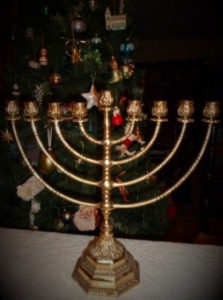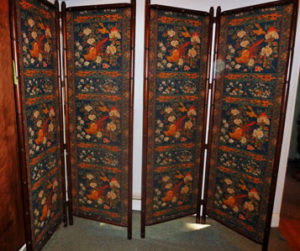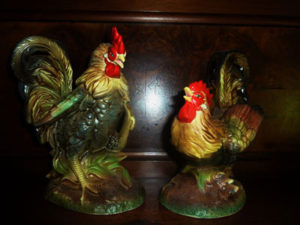by Lisa C. Cantwell
“I bought this large menorah at a thrift store for $8.00. It’s made of ornate, heavy brass and is in “like new” condition. What is it worth?”

— R. Higgins, Blue Ridge Summit, Pennsylvania
You have a Hanukkah treasure! Just in time for the holiday season, you have found a beautiful Menorah for a bargain price. The Menorah is described in the Bible as the seven-lamp ancient Hebrew lampstand made of pure gold. It was used in a portable sanctuary set up by Moses in the wilderness. Some three hundred years later, it was found in the Temple in Jerusalem. Even though the holy Temple was destroyed, a Menorah is still traditionally lit in every Jewish home on the holiday of Hanukkah. Although today’s modern nine-branch version is quite different from the original, it still shares the basic function of spreading light. The seven lamps of the Menorah allude to knowledge, with six of the branches representing human wisdom, guided by the center branch of divine light. If there are no identifying marks on it, and since you don’t know its provenance, I’d rather not date it. Still, heavier brass Menorahs such as this one retail for $75.00 and up. Thank you for sharing this traditional Jewish candelabrum.
“My mother bought these two screens at an antique mall in Emmitsburg. They are six-and-a-half-feet tall, with walnut frames and brass hinges. They weigh about 40 lbs. each. The fabric may be linen or heavy cotton. There is a small hole and scratch in the material on one of the back panels. What can you tell us about them?”

— Thomas Gray, Maryland
It appears your mom purchased a reproduction treasure! The screens are most likely English and date to the 1950s, so they would be considered vintage. They were made to represent the period during which bamboo furnishings were popular, from about 1880 to about 1920. The bird of paradise pattern on the fabric was quite popular around this period, also. The vibrant colors and overall condition are a giveaway as to this pair’s age, though. The screens might have been used as a divide in a dining room, garden/sun room, or in the boudoir. At any rate, they were meant to provide an elegant backdrop or hide unsightly clutter in a spacious room. Screens, while not a necessity, are always a decorative asset, provided there’s adequate space to showcase them. A fair asking price for both would be $300 in their present condition. Without any tears in the fabric or flaws in the finish on the frames, they might bring as much as $500. Although not antique, they are beautiful.
“This rooster and hen were in my mother-in-law’s collection. There are stickers on the bottom of each that read: “NapcoWare Import Japan.” The number 6692 is impressed on the bottom. Are they old, and what, if any, is their value?”

— C.L., Thurmont
Chicken figurines are always a treasure! As for being “old,” only if you’re a millennial, as this pair dates to the late 1950s. Napco, or National Potteries Cooperation, began producing figurines, collectibles, decorative glass, and porcelain ceramics in 1938. During the late 1950s and early 1960s, their products were popular here in the United States, as they were affordable and beautifully colored and detailed. Your rooster and hen showcase the quality of some of their better hand-painted porcelain ceramics. They are in excellent condition, with no visible chips or cracks. Remarkably, the colors have not faded. Should you decide to part with them, tag the pair for $45. A vintage “chicken lover” would likely be willing to pay that price.

